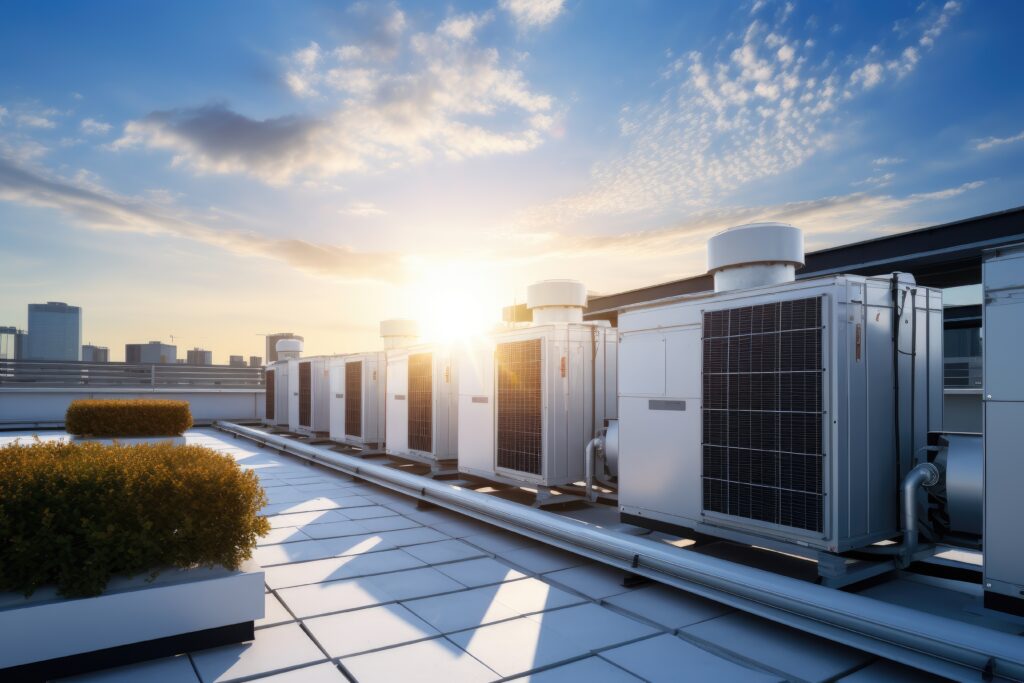In today’s fast-paced business environment, reducing operational costs is more important than ever. One often overlooked area where companies can save money is through HVAC optimization. Heating, ventilation, and air conditioning systems are essential for maintaining a comfortable and productive environment in commercial buildings, but they also account for a significant portion of a company’s energy expenses. In fact, HVAC systems can represent up to 40% of a building’s total energy use. This staggering figure highlights the potential savings businesses can achieve by optimizing these systems. Energy management systems (EMS), like those offered by Entouch, allow businesses to fine-tune their HVAC operations to reduce waste and improve efficiency. The result? A leaner operation with significant cost savings, year after year.
Optimizing HVAC systems isn’t just about cutting costs, though that is a major benefit. It also leads to fewer maintenance issues, longer system lifespans, and improved environmental sustainability. When an HVAC system runs efficiently, it doesn’t have to work as hard, which means fewer breakdowns and costly repairs. Over time, these small adjustments add up, resulting in substantial financial savings. But the question remains: how much could your business save by optimizing its HVAC system? The answer might surprise you. By implementing a smart EMS to control and monitor HVAC performance, businesses can reduce their energy usage by up to 30%, translating into thousands of dollars saved annually.
The growing importance of energy efficiency in commercial buildings
Energy efficiency has moved from being a “nice-to-have” to a business necessity. In commercial real estate, where profit margins are constantly squeezed, any opportunity to reduce overhead is highly valuable. HVAC systems, being one of the largest energy consumers in any building, offer significant potential for savings. The growing emphasis on sustainability, both from consumers and regulatory bodies, has only increased the importance of energy-efficient solutions. Reducing energy waste isn’t just good for the planet, it’s good for business. Moreover, energy-efficient buildings are often seen as more attractive investments, driving demand and potentially increasing property values. In this sense, optimizing HVAC systems not only cuts immediate costs but can improve long-term business outcomes as well.
Implementing energy efficiency measures in commercial buildings can be as simple as adjusting thermostat settings or as complex as installing a full energy management system. The beauty of HVAC optimization is that it can scale to meet the needs of any business, large or small. By integrating smart systems like those provided by Entouch, businesses can monitor their energy consumption in real-time and make adjustments on the fly. This kind of dynamic control ensures that energy waste is minimized without sacrificing comfort, all while keeping operational costs under control. What’s more, energy-efficient buildings can qualify for various green certifications, which can provide additional financial incentives.
How inefficient HVAC systems affect your bottom line
When an HVAC system is not optimized, it’s like pouring money down the drain. Inefficient systems consume far more energy than necessary, often running at full capacity even when conditions don’t require it. Imagine leaving your car engine running overnight; it’s wasteful and costly. The same goes for an HVAC system that isn’t tuned to the building’s specific needs. Factors like fluctuating occupancy levels, outside weather conditions, and peak usage times can all affect the optimal operation of your HVAC system. Without proper management, these variables lead to unnecessary energy consumption and inflated utility bills. This inefficiency can have a significant impact on your bottom line, especially for multi-site businesses that manage numerous locations.
Worse still, inefficient systems often lead to premature wear and tear, resulting in more frequent repairs and even early replacement. When systems are forced to work harder than they should, they are more likely to fail, leading to costly repairs that eat into your operational budget. These unexpected breakdowns not only cost money but can also lead to downtime, reducing productivity and impacting your business operations. Optimizing your HVAC system mitigates these risks by ensuring that equipment runs as efficiently as possible, extending its lifespan and minimizing repair costs. The financial benefits of preventing these issues are undeniable.
What is HVAC optimization?
HVAC optimization refers to the process of improving the efficiency of heating, ventilation, and air conditioning systems to minimize energy consumption while maintaining a comfortable indoor environment. This process typically involves the use of smart technology and automation to monitor and adjust the performance of HVAC systems in real-time. Instead of relying on outdated, manual controls, optimized systems use advanced algorithms and data analytics to automatically adjust temperature settings, fan speeds, and other variables based on real-time conditions. This ensures that the system is only using the energy it needs, without wasting resources.
At the heart of HVAC optimization is the ability to collect and analyze data. Sensors installed throughout the building feed data into a central system, which can then make intelligent decisions about how to optimize HVAC performance. For instance, during periods of low occupancy, the system can automatically reduce the heating or cooling load, saving energy without sacrificing comfort. Some systems also incorporate weather forecasts, adjusting the HVAC settings based on predicted outdoor conditions. The result is a finely-tuned system that operates at peak efficiency, providing a comfortable environment for occupants while minimizing energy costs.
The role of energy management systems in HVAC optimization
Energy management systems (EMS) are essential for achieving true HVAC optimization. An EMS allows businesses to monitor their energy usage in real-time, giving them the insights they need to make informed decisions. By integrating HVAC systems into an EMS, businesses can gain unprecedented control over their energy consumption. These systems can be programmed to automatically adjust HVAC settings based on occupancy, time of day, or even weather conditions. For example, an EMS can reduce the cooling load during cooler hours or adjust ventilation rates when occupancy levels decrease.
The power of an EMS lies in its ability to provide actionable insights. Advanced analytics can identify patterns of energy use and pinpoint areas where energy is being wasted. For example, if a business consistently uses more energy during off-peak hours, the EMS can suggest changes to scheduling or equipment settings to reduce consumption. Moreover, EMS platforms often include predictive maintenance features, which can alert facility managers to potential HVAC issues before they become major problems. This proactive approach not only reduces energy consumption but also extends the lifespan of HVAC equipment, leading to additional cost savings.
Real-life savings from HVAC optimization: case studies
Several businesses have already reaped the financial benefits of HVAC optimization through smart energy management systems. For instance, a major retail chain implemented an EMS solution and saw a 25% reduction in their annual energy costs. By optimizing their HVAC systems across multiple locations, they were able to save hundreds of thousands of dollars each year. Another case study involves a national restaurant franchise that reduced their energy consumption by 30% after integrating smart controls into their HVAC system. The savings they achieved were reinvested into other areas of the business, allowing them to grow while keeping operational costs low.
These real-world examples demonstrate the potential impact that HVAC optimization can have on a business’s financial performance. Whether it’s a small business with a single location or a large enterprise with multiple facilities, the principles remain the same. By using tools like those offered by Entouch, businesses can make smarter decisions about how they use energy, leading to significant cost savings over time. The return on investment for HVAC optimization is often realized within just a few years, making it a highly attractive option for cost-conscious businesses.
The environmental impact of optimizing HVAC systems
Beyond financial savings, optimizing HVAC systems has a profound environmental impact. Reducing energy consumption not only cuts costs but also lowers greenhouse gas emissions, helping businesses reduce their carbon footprint. In an age where environmental sustainability is becoming a competitive differentiator, businesses that take steps to reduce their energy use can position themselves as leaders in the green economy. HVAC optimization plays a critical role in this effort, as it targets one of the largest sources of energy use in commercial buildings.
By implementing smart energy management systems, businesses can contribute to global efforts to reduce energy waste and combat climate change. Many organizations are already setting ambitious sustainability goals, and HVAC optimization is a practical step toward achieving those objectives. Additionally, businesses that prioritize energy efficiency can often qualify for government incentives or tax credits, further enhancing the financial benefits of optimizing their HVAC systems. For those looking to make a positive environmental impact while also improving their bottom line, HVAC optimization offers a clear path forward.
How to start optimizing your HVAC system today
The process of optimizing your HVAC system doesn’t have to be complicated. The first step is to assess your current system and identify areas where energy is being wasted. This might involve conducting an energy audit or using monitoring tools to track your HVAC performance. Once you have a clear understanding of your system’s inefficiencies, you can begin implementing changes. This could involve simple adjustments like programming thermostats more effectively or more comprehensive solutions like installing a full energy management system.
For businesses looking to take a proactive approach, investing in a smart EMS is a game changer. These systems, such as those provided by Entouch, give businesses the ability to monitor and control their HVAC systems remotely, making real-time adjustments to optimize performance. With EMS, you’ll gain access to detailed analytics and insights that allow you to fine-tune your energy use and ensure that you’re operating as efficiently as possible. By taking the leap into HVAC optimization, you’re not just cutting costs; you’re making an investment in the long-term sustainability and profitability of your business. Entouch offers innovative solutions to help businesses achieve these goals.
Why businesses should prioritize HVAC optimization in 2024 and beyond
As energy costs continue to rise and environmental regulations become stricter, businesses can no longer afford to ignore the inefficiencies in their HVAC systems. Optimizing HVAC performance is no longer just a nice-to-have; it’s a critical component of a smart business strategy. Businesses that invest in HVAC optimization today will be better positioned to succeed in an increasingly competitive marketplace, where every dollar saved on energy can be reinvested in growth and innovation.
Looking ahead to 2024 and beyond, the importance of energy efficiency will only continue to grow. Companies that prioritize sustainability, reduce their carbon footprints, and embrace smart technology will find themselves leading the way into the future. For those who are ready to take control of their energy costs, the time to act is now. HVAC optimization isn’t just about cutting bills—it’s about creating a smarter, more efficient, and more sustainable future for your business.



